Normandy: The Pegasus Bridge
We rose early in the morning in Abbeville for another 2 hour drive to our first destination in Normandy. This was the Pegasus bridge. This bridge was on the Eastern flank of the invasion and would serve as the pivot for invasion forces as they swung to the north. Holding the bridge was crucial to prevent the Germans from flanking the invasion. A group of English commandos flew in via gliders. They landed in a field nearby and successfully captured and defended the bridge until reinforcements came from Sword beach. This operation was one of the few operations that went as planned on D-day.
The bridge over a canal was a counter weighted draw bridge. It has since been replaced with a larger version and moved to the neaby site of the museum. This area is near the city of Caen on the map below.
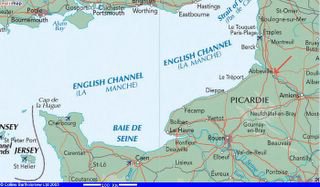
Map of Normandy
Here we see part of the bridge's enormouse counter weight behind the Bofur's gun used by the British troops.

The bridge's counterweight
Here is Redington walking on the bridge where wreaths of poppies have been laid in memory of the soldiers lost.
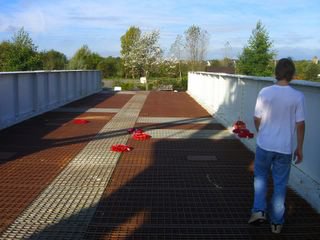
The bridge with wreaths of poppies for some of the dead
They had a replica of one of the gliders the commandos flew in on as well as the tattered remains of an original glider. These gliders were almost all wood construction and were thin and flimsy. You could imagine being packed in there with a jeep or small tank and the fear of landing. Many gliders crashed into the hedgerows ringing the fields with great casualties and loss of equipment because pre-invasion intelligence failed to identify the hedgrows in France being much taller than the English equivalent.

One of the gliders used to land British commandos
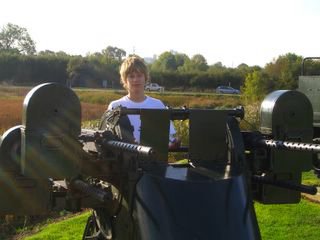
Redington stands ready at the anti-aircraft gun
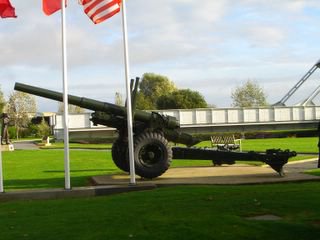
A British field gun with the captured bridge in the background
Inside the museum was a great exhibit showing the military hardware, stories about the Ox and Bucks regiment that mounted the assault, and films on the invasion. I was struck by how cheaply fabricated the weapons were. The Bren gun pictured here is made mostly of stamped metal and roughly formed wood. It is hard to imagine it was as leathal as it was. I came to understand how much economics drove the war effort as millions of soldiers had to be equiped effectively for the cheapest cost.
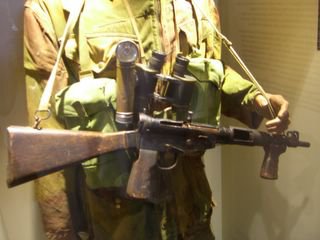
The Bren gun and typical British equipment
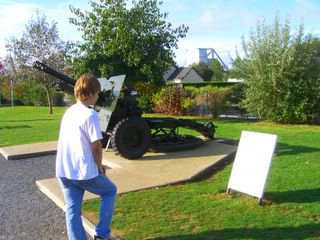
Redington studies a British gun
Now that we've visited the Pegasus bridge it is time for the next stop; a German radar installation at Douvre.
The bridge over a canal was a counter weighted draw bridge. It has since been replaced with a larger version and moved to the neaby site of the museum. This area is near the city of Caen on the map below.

Map of Normandy
Here we see part of the bridge's enormouse counter weight behind the Bofur's gun used by the British troops.

The bridge's counterweight
Here is Redington walking on the bridge where wreaths of poppies have been laid in memory of the soldiers lost.

The bridge with wreaths of poppies for some of the dead
They had a replica of one of the gliders the commandos flew in on as well as the tattered remains of an original glider. These gliders were almost all wood construction and were thin and flimsy. You could imagine being packed in there with a jeep or small tank and the fear of landing. Many gliders crashed into the hedgerows ringing the fields with great casualties and loss of equipment because pre-invasion intelligence failed to identify the hedgrows in France being much taller than the English equivalent.

One of the gliders used to land British commandos

Redington stands ready at the anti-aircraft gun

A British field gun with the captured bridge in the background
Inside the museum was a great exhibit showing the military hardware, stories about the Ox and Bucks regiment that mounted the assault, and films on the invasion. I was struck by how cheaply fabricated the weapons were. The Bren gun pictured here is made mostly of stamped metal and roughly formed wood. It is hard to imagine it was as leathal as it was. I came to understand how much economics drove the war effort as millions of soldiers had to be equiped effectively for the cheapest cost.

The Bren gun and typical British equipment

Redington studies a British gun
Now that we've visited the Pegasus bridge it is time for the next stop; a German radar installation at Douvre.
Comments